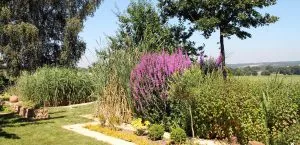Beautify your garden with your sanitation

Phyto-purification: natural and ecological harmony for your garden
When it comes to improving the aesthetics and functionality of your garden, phyto-purification systems are a unique and innovative solution that is both environmentally friendly and aesthetically pleasing. These systems use specially selected plants to filter and purify wastewater, creating a miniature ecosystem that not only replaces the septic tank or micro-station but also enriches local biodiversity.
What makes phyto-purification systems truly unique is that they are the only sanitation systems that are open to visitors. Unlike traditional installations, which are often hidden or buried, phyto-purification blends harmoniously into the landscape of your garden. Visitors can admire the plants used which attract bees, butterflies and other pollinators, adding a touch of life and colour to your outdoor space.
What’s more, by opting for phyto-purification, you are actively contributing to the preservation of the environment. This system reduces your home’s ecological footprint by using natural processes to treat wastewater, thus avoiding the use of chemicals or heavy infrastructure. Ultimately, phyto-purification transforms a simple garden into a living example of sustainability and harmony with nature, while making your outdoor space more attractive and functional.
Phyto-purification: a natural and aesthetic solution
Phyto-purification is a set of natural techniques for purifying wastewater using plants. More specifically, it is a method of wastewater treatment that relies on a combination of microorganisms and plants in an ecosystem specially designed for this purpose. The principle behind phyto-purification is simple: a plant filter is created to collect wastewater from homes.
The wastewater from the home arrives on the surface of the filter which is planted with reeds. The role of the reeds is mainly mechanical: the development of the stems and rhizomes maintains the permeability of the filter over the long term, and the roots as a whole harbour an ecosystem that is very rich in bacteria and other micro-organisms. The reed filter is divided into two parts that are fed alternately. The upper layer of the filter is made up of sand which acts as a sieve, retaining the solid matter on the surface of the filter. This matter will quickly compost while the water passes vertically through the entire filtering bed. The bacteria present in the filtering bed will digest the pollution and the water continues on its way to the infiltration zone. The compost on the surface is not waste that needs to be removed regularly. It only needs to be removed about once every ten years. Once removed, this compost can be reused in an environmentally friendly and beneficial way, particularly as a natural fertiliser in an ornamental garden. This not only enables the reuse of waste, but also enriches the soil in a sustainable and environmentally friendly way.
The Sanitation Garden: a green and functional process
The Sanitation Garden is a natural process using a phyto-purification system, offering both aesthetic and ecological advantages. This type of garden harmoniously integrates purifying plants into a landscaped setting, transforming a technical process into a pleasant green space. In addition to playing an important role in wastewater treatment, the Sanitation Garden becomes a visual and ecological asset for the property.
The plants selected for this garden, such as reeds, irises and sedges, also provide botanical diversity that attracts pollinators and enriches local biodiversity. These plants benefit from the natural compost formed by the phyto-purification process, which promotes their growth and flowering.
The advantages of the Sanitation Garden
An economical alternative
In principle, the installation of a Sanitation Garden is an investment. The initial cost, although reasonable, is slightly higher than that of an ordinary septic tank, but you quickly get your money’s worth. After installation, however, the garden is completely self-sufficient and highly durable. In other words, it does not require emptying, let alone any maintenance by a professional. You will not need to buy any more plants or replace the installation. In the long term, this investment is therefore much more advantageous than any other sanitation system. These gardens have the same lifespan as a house.
An environmentally friendly solution
Sanitation Gardens allow solid matter to be broken down directly into compost on site, thus eliminating the need for transport and the associated pollution. With these gardens, the energy normally used for waste treatment in water treatment plants is saved. Only French products are used when installing the gardens. To reduce the carbon footprint, the emphasis is on the use of local resources, for example, the plants and aggregates come from the customer’s region.
An aesthetic asset
Like a traditional green space, the Sanitation Garden contributes to the aesthetics of your garden. The plants are chosen not only for their performance and usefulness, but also to add a decorative touch to the space. The system blends in easily with the decor of the house or the area where it is installed.
Gardening maintenance
The Sanitation Garden is maintained in the same way as a conventional garden, with annual mowing being the only necessity. The vegetated filter generally needs cleaning every ten years, without the need for cleaning products.

